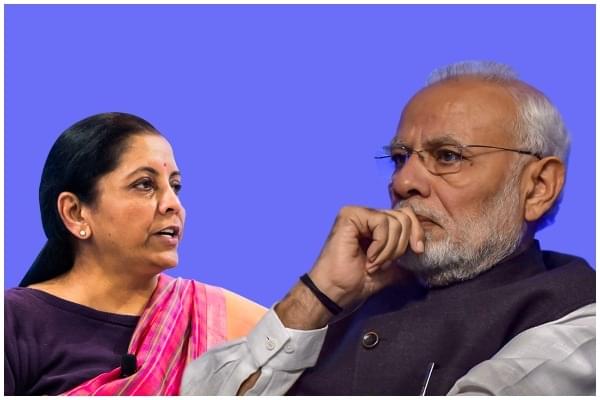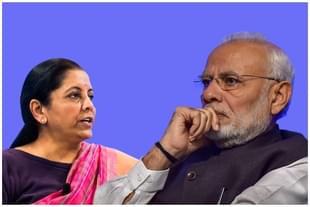Economy
What GDP Data Is Telling Us: Don’t Obsess With Inflation, Spend On Public Goods, Relief To Poor
R Jagannathan
Jun 01, 2021, 11:47 AM | Updated 11:46 AM IST
Save & read from anywhere!
Bookmark stories for easy access on any device or the Swarajya app.


The big question to ask about growth and economic revival in 2021-22, now that we have last year’s gross domestic product (GDP) and fourth quarter (Q4) estimates, is what do we do with this information.
Do we stimulate the economy more or maintain course? What do we do with the emerging problems of inflation and the likelihood of higher fiscal deficits this fiscal, given the huge second wave of Covid, demands for universalising vaccinations, and preparing for a third wave?
How do we make a virtue of necessity, given that Covid-19 isn’t about to drop dead anytime soon?
I will leave the detailed analysis of the GDP numbers to the professional economists. What I will highlight here are the possibilities and approaches to take now, since the Covid-related problem will remain.
How we look at our problems will tell us more about what to do than rushing to find answers to questions at the top of our minds like how to get GDP up, etc.
The National Statistics Office (NSO) told us yesterday (31 May), in fact confirmed to us, that the Indian economy was back on the growth path from the third quarter. That quarter was followed up with further growth in the fourth. We got 0.4 per cent GDP growth in Q3, and 1.6 per cent in Q4. Overall, 2020-21 saw a lower-than-expected dip of -7.3 per cent in GDP.
But here’s what we should be looking at: while GDP in real terms fell 7.3 per cent, in nominal terms it fell by only 3 per cent. This means, in money terms (before adjustment for inflation), we have not done too badly.
At 72.5 to the dollar, our money GDP of Rs 196 lakh crore works out to around a GDP figure of $2.7 trillion. If the rupee stays strong, our $5 trillion target may not be missed by much if we make the right decisions now.
The above figures imply that most of the GDP damage has been done by inflation. Not surprising, since the lockdowns damaged supply chains and disrupted production all over, especially in non-IT services. This has shown up in the 10.49 per cent rise in the wholesale prices index for April, and the 4.2 per cent rise in retail inflation.
The question is: do we target inflation or growth? To me the answer is clear, we must ignore inflation till it reaches at least 6 per cent before trying to contain it. At the level of consumer psychology, more money in the hand always looks better than less money with lower inflation, which anyway cannot be guaranteed if lockdowns keep happening in multiple states and there is a third wave to reckon with.
So, my first conclusion, is ignore headline inflation till it demonstrably gets worse and rises above 6 per cent for at least two quarters. Incidentally, former member of the Monetary Policy Committee (MPC) Ravindra Dholakia believes that India’s threshold rate of inflation tolerance is 6 per cent and not the 4 per cent mandate given to the MPC. We need to reset the tolerance bands wider, where six percent can be tolerated if growth is an issue, as is the case now.
The second issue is: how do we help our people, given our stretched fiscal resources?
Here again, we must use commonsense, and not some rough and ready measure of an ideal fiscal limit. We must spend, and spend in the right areas. This means the state must work both to put money in the hands of the poor, and food on their plates. There is no other option, for the Centre for Monitoring Indian Economy (CMIE) estimates that 97 per cent of Indians suffered have suffered income losses post-Covid.
In this situation, commonsense economics tells us that no one is going to spend in a hurry even if we bid the second wave of Covid-19 goodbye in the next two months. People will be conserving what they have for a possible next wave, which could wipe out their remaining savings, or bring them into deep debt. This means consumption will stay weak, and so will investment.
The answer is thus to spend, spend, spend — but in the high impact areas.
First, borrow more and clear all state compensation dues outstanding for 2020-21 and those that will arise this year. Asking states to borrow and then retiring that debt by prolonging the cess on goods and services tax (GST) indefinitely into the future will do nothing to make states happy, whether they are run by the opposition or Bharatiya Janata Party (BJP). Nor will it do much to revive discretionary demand, which is the key to consumption and investment growth.
The BJP must bite the bullet on this, and take away the one grouse that states can have against the Centre in this Covid year. Also, since it is states that must fight the Covid pandemic with their resources, it is also the moral thing to do. They cannot be left with empty coffers. And yes, the vaccine policy must be tweaked where 90 per cent of it is bought by the Centre and supplied free to states, with 10 per cent left to the private sector to buy at market-related prices.
Second, where we spend is also important. In this super Covid year, government spending — both by Centre and states — must be focused on health. But more than just health, Covid can be turned into an opportunity where we correct the mistakes of seven decades where we focused not on basic public goods (health, education, law and order, defence, etc) but freebies given to win elections.
Resources from other areas can be pulled into public goods, and states can be told that the Centre will clear compensation dues pronto provided none of them uses it for freebies and electoral gains. There is, of course, no guarantee states will do this, but at least there will be a moral commitment to do so. Universal vaccination is a public good, too.
Other obvious areas to splurge on are MGNREGA and cash payouts. Food kitchens in cities with large migrant populations are something worth pondering about.
Three, the suggestions of Tamil Nadu Finance Minister Palanivel Thiagarajan (PTR) on reworking GST and Centre-state fiscal ties must be heeded to, even though PTR has a tendency to upset everyone with his abrasive manners. The Centre should not stand on ego, whether it is in dealing with Tamil Nadu or West Bengal.
Unfortunately, as the latest incident over the recall of the West Bengal Chief Secretary to Delhi overnight shows, the Centre is gaining no goodwill points with the people of Bengal or of India by behaving in this petulant manner. Leave the petulance to Mamata Didi.
Four, the focus must shift from GDP itself to its components. It has been obvious for some time that growth can happen without creating too many jobs. This means that focusing too much on growth can blindside us to its social consequences. Jobs depend not only on growth but on the sectors leading that growth. This means following sensible sectoral revival strategies, so that growth comes with jobs.
Health, education, public transport, and law and order are the areas with maximum job potential, and these sectors are also the ones that suggest themselves for special treatment in terms of investment and incentivisation in this Covid year.
Five, the MSME (micro, small, medium enterprises) sector is the biggest job creator. Formalisation in this sector has been a painful experience, not because of the complexity of the GST system alone, but because state- and central-level regulatory regimes make compliance a high-cost affair.
Most of them would thus be happier in the informal, cash economy, and not in the tax-paid economy. Removing regulatory 'cholesterol', to use Manish Sabharwal’s evocative term, should be the goal of both Centre and states. GST can, of course, be made less painful, but the real pain is elsewhere, and all-pervasive.
Covid-19 is a god-sent opportunity to do the things we never bothered to do when the going was good.
Jagannathan is former Editorial Director, Swarajya. He tweets at @TheJaggi.





